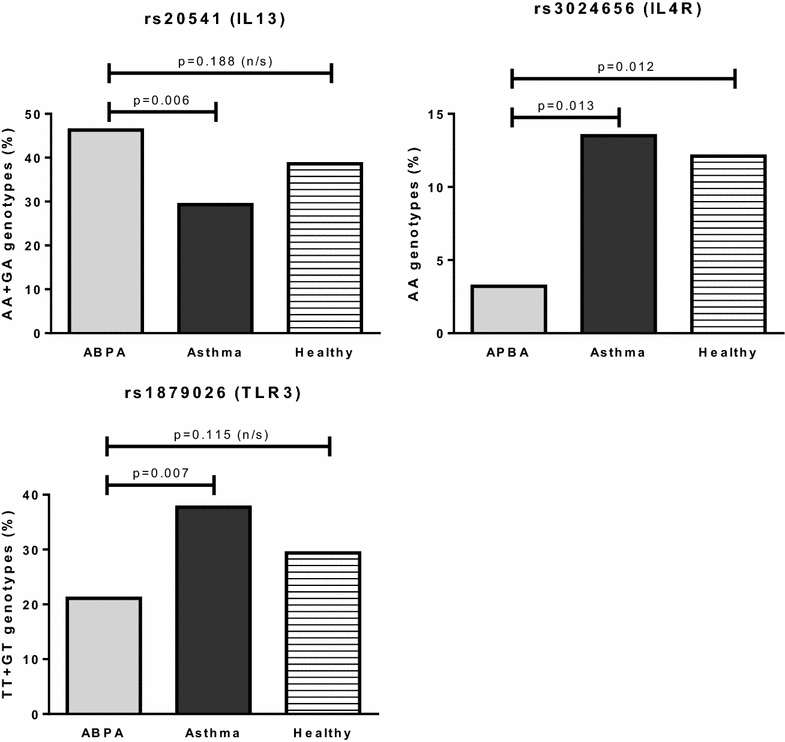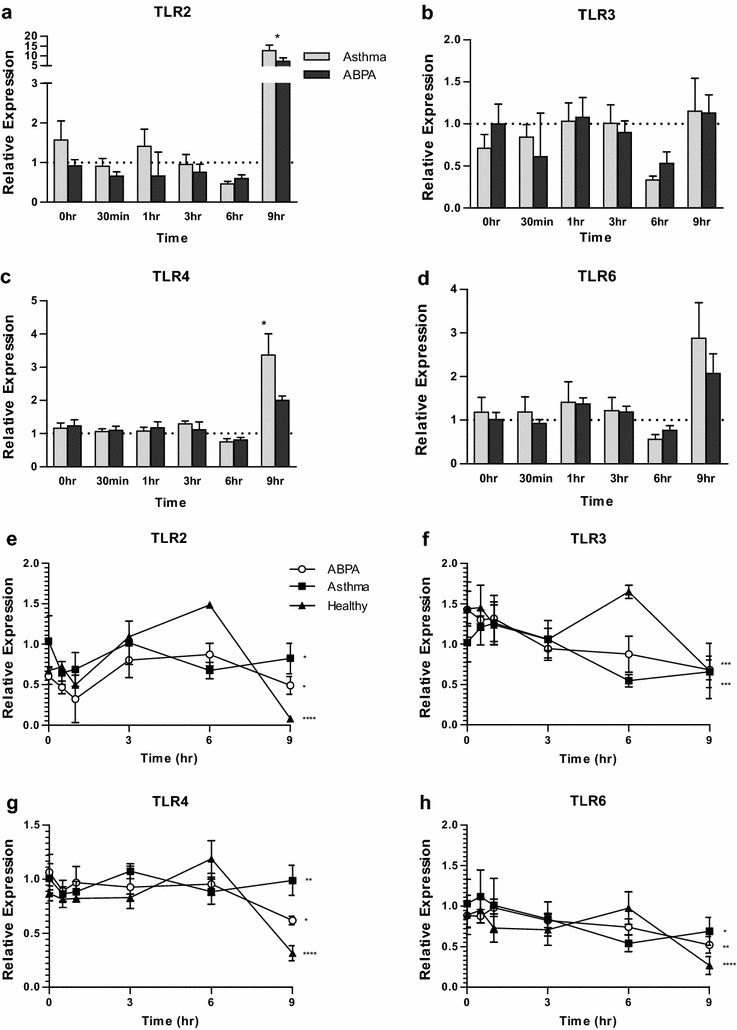Genetic susceptibility to allergic bronchopulmonary aspergillosis in asthma: a genetic association study
- PMID: 27708669
- PMCID: PMC5037889
- DOI: 10.1186/s13223-016-0152-y
Genetic susceptibility to allergic bronchopulmonary aspergillosis in asthma: a genetic association study
Abstract
Background: In patients with asthma, the fungus Aspergillus fumigatus can cause allergic bronchopulmonary aspergillosis (ABPA). Familial ABPA is reported, and some genetic factors have been associated with the disease, however, these are small studies (n ≤ 38) and do not explain all cases of ABPA.
Methods: We analysed SNPs in 95 ABPA patients, comparing frequencies to 152 atopic asthmatic and 279 healthy controls. Twenty two genes were selected from literature, and 195 tagging SNPs were analysed for genetic association with ABPA using logistic regression corrected for multiple testing. We also analysed monocyte-derived macrophage gene expression before and during co-culture with A. fumigatus.
Results: Seventeen ABPA-associated SNPs (ABPA v Atopic asthma) were identified. Three remained significant after correction for multiple testing; IL13 rs20541, IL4R rs3024656, TLR3 rs1879026. We also identified minor differences in macrophage gene expression responses in the ABPA group compared to the control groups.
Conclusions: Multiple SNPs are now associated with ABPA. Some are novel associations. These associations implicate cytokine pathways and receptors in the aberrant response to A. fumigatus and susceptibility to ABPA, providing insights into the pathogenesis of ABPA and/or its complications. We hope these results will lead to increased understanding and improved treatment and diagnostics for ABPA.
Keywords: ABPA; Asthma; Genetic susceptibility; IL13; IL4R; TLR3.
Figures



Similar articles
-
Molecular-based allergy diagnosis of allergic bronchopulmonary aspergillosis in Aspergillus fumigatus-sensitized Japanese patients.Clin Exp Allergy. 2015 Dec;45(12):1790-800. doi: 10.1111/cea.12590. Clin Exp Allergy. 2015. PMID: 26118958
-
Role of Aspergillus fumigatus-Specific IgE in the Diagnosis of Allergic Bronchopulmonary Aspergillosis.Int Arch Allergy Immunol. 2019;178(4):338-344. doi: 10.1159/000495365. Epub 2019 Jan 9. Int Arch Allergy Immunol. 2019. PMID: 30625471
-
Mutations in EEA1 are associated with allergic bronchopulmonary aspergillosis and affect phagocytosis of Aspergillus fumigatus by human macrophages.PLoS One. 2018 Mar 16;13(3):e0185706. doi: 10.1371/journal.pone.0185706. eCollection 2018. PLoS One. 2018. PMID: 29547649 Free PMC article.
-
Lymphocytes in allergic bronchopulmonary aspergillosis.Front Biosci. 2003 May 1;8:d589-602. doi: 10.2741/994. Front Biosci. 2003. PMID: 12700106 Review.
-
Aspergillus-associated hypersensitivity respiratory disorders.Indian J Chest Dis Allied Sci. 2008 Jan-Mar;50(1):117-28. Indian J Chest Dis Allied Sci. 2008. PMID: 18610696 Review.
Cited by
-
Respiratory Outcomes and Aspergillus Serology Following Elexacaftor/Tezacaftor/Ivacaftor Therapy in People with Cystic Fibrosis and a History of Aspergillus fumigatus Infection.Lung. 2025 Jan 6;203(1):24. doi: 10.1007/s00408-024-00781-4. Lung. 2025. PMID: 39762638
-
Proteomic Analysis of Serum Differentially Expressed Proteins Between Allergic Bronchopulmonary Aspergillosis and Asthma.Mycopathologia. 2021 Mar;186(1):1-13. doi: 10.1007/s11046-020-00506-0. Epub 2020 Nov 12. Mycopathologia. 2021. PMID: 33184749
-
Fungal lung disease.Eur Respir J. 2024 Nov 28;64(5):2400803. doi: 10.1183/13993003.00803-2024. Print 2024 Nov. Eur Respir J. 2024. PMID: 39362667 Free PMC article. Review.
-
A Comprehensive in Silico Analysis of Regulatory SNPs of Human CLEC7A Gene and Its Validation as Genotypic and Phenotypic Disease Marker in Recurrent Vulvovaginal Infections.Front Cell Infect Microbiol. 2018 Mar 20;8:65. doi: 10.3389/fcimb.2018.00065. eCollection 2018. Front Cell Infect Microbiol. 2018. PMID: 29616193 Free PMC article.
-
Variants of human DECTIN-1 rs16910526 are linked to differential reactive oxygen species production and susceptibility to tuberculosis.J Biomed Sci. 2024 Aug 5;31(1):77. doi: 10.1186/s12929-024-01067-w. J Biomed Sci. 2024. PMID: 39103844 Free PMC article.
References
-
- Stevens DA, Moss RB, Kurup VP, Knutsen AP, Greenberger P, Judson MA, Denning DW, Crameri R, Brody AS, Light M, et al. Allergic bronchopulmonary aspergillosis in cystic fibrosis–state of the art: cystic Fibrosis Foundation Consensus Conference. Clin Infect Dis. 2003;37(Suppl 3):S225–S264. doi: 10.1086/376525. - DOI - PubMed
-
- Agarwal R, Aggarwal AN, Gupta D, Jindal SK. Aspergillus hypersensitivity and allergic bronchopulmonary aspergillosis in patients with bronchial asthma: systematic review and meta-analysis. Int J Tuberc Lung Dis. 2009;13:936–944. - PubMed
LinkOut - more resources
Full Text Sources
Other Literature Sources

